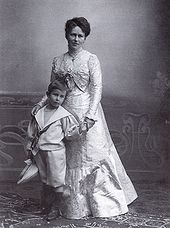Villa Grünau

The Villa Grünau, built in 1887 and 1888 in the Vorarlberg community of Kennelbach, was the seat of the Schindler family until 1950 and was then rented out. In 1992 the municipality of Kennelbach acquired the building, which had now become dilapidated, and housed the municipal office in addition to apartments.
meaning
Several aspects make the Villa Grünau an important historical building. The industrialist villa is a symbol of the enormous profits made by Vorarlberg manufacturers during the period of early and high capitalism. But the building was also a place of significant inventions. Landlord Friedrich Wilhelm Schindler experimented with electricity in the basement of the villa; At the world exhibition in Chicago in 1893, he presented his revolutionary inventions, including a fully electrified kitchen, as a world first.
The electric house
In the population, the Villa Grünau was also known as the "electric house", because Friedrich Wilhelm Schindler had furnished the villa with many of his inventions. There was an electric stove and an oven before 1900. The rooms were heated electrically, the servants ironed electrically and Schindler lit his cigar electrically.
There was even a vacuum cleaner system that ran through the whole house in a pipe system. In addition to these devices, which were unique at the time, the villa is also equipped with all the features of a manorial building. Wall paintings, a splendid music hall, a large dome, ornate lighting fixtures and an extensive park complete the property.
The Villa Grünau was built at the time when other Vorarlberg industrialists were also building their villas in Dornbirn , Feldkirch and Thuringia . The palatial buildings of the manufacturers underlined the economic power of the entrepreneurs. The industrialist mansions had to be large and the halls so wide that the individual in them became aware of their smallness. In private life too, the industrialists set themselves apart from the village population. In order to keep the relationships between the children and the local population as low as possible, the Schindler family always brought the staff from abroad. The teacher came from Prussia, the other employees were Swiss.
Financing through huge profits
In 1838 the Schindler and Jenny families opened the cotton spinning mill in Kennelbach, where they could use the water power of the Bregenzer Ach . The factory offered the impoverished population new earning opportunities, but the workers became completely dependent on the entrepreneur. In the 1860s, Kennelbacher kk worked 13 hours a day . Cotton spinning the rule. Since there were no legal provisions, nine and ten year old children also worked in Vorarlberg's textile factories. The wages of the workers were bad.
In return, the industrialists made such a profit that, in addition to building the Villa Grünau, they were also able to finance the purchase of most of the land in the region. However, it has also been proven that the Kennelbach industrialists, despite their capitalist attitude, introduced a health and death fund for their workers and founded workers' houses, because many of the workers had immigrated from the region of Trentino, which at the time belonged to the Austro-Hungarian monarchy .
The villa as the seat of the Schindler family
In the immediate vicinity of the spinning factory was a workshop that was built in 1837/1838 on a single storey. In 1845 the manufacturers submitted plans to add floors to the villa. After several renovations, the former workshop became the Upper Villa - a representative building in the middle of a large park with a fountain and fallow deer. After various inheritances, purchases and sales in the branched Schindler and Jenny families, the upper villa was given up in 1905, now the Villa Grünau was the seat of the family. Friedrich Wilhelm received the building as a gift from his father Samuel Wilhelm on the occasion of his wedding to Maria Margaretha Verena Jenny and moved into it in 1887.
After Friedrich died in 1920, Maria lived alone with a few servants in the villa for many years until her death in 1944.
Fritz Schindler was the last of the family to live in the villa. In 1936 he acquired Wolfurt Castle , and in 1950 he moved from Villa Grünau to Wolfurt. Fritz Schindler died in 1969. A year earlier, Textilwerke Schindler & cie had been dissolved after an unsuccessful period during and after the Second World War. The Wolfurt castle was the 2017 community Wolfurt sold.
literature
- Egon Sinz : The Villa Grünau. Kennelbach community. Kennelbach 1992.
Web links
Coordinates: 47 ° 28 ′ 44.7 " N , 9 ° 45 ′ 44.2" E





